Engineering Ethics: The Minnesota I-35W Bridge Collapse (Ohio Timed & Monitored)
Credit: 2 PDH
Subject Matter Expert: Edward P. Brunet, Jr., P.E.
In Engineering Ethics: The Minnesota I-35W Bridge Collapse , you'll learn ...
- The original bridge design and design errors that led to the disaster
- The important role of quality control procedures for designing, reviewing, and approving bridge design plans and calculations
- The responsibilities of engineers as they relate to public safety, regulatory authorities, and liability issues
Overview

To meet the Ohio Board's intent that online courses be "paced" by the provider, a timer will be used to record your study time. You will be unable to access the quiz until the required study time of 100 minutes has been met.
Credit: 2 PDH
Length: 25 pages
On August 1, 2007, the I-35W Bridge over the Mississippi River in Minneapolis, Minnesota, collapsed during the evening rush hour, plummeting into the river and onto the concrete embankment below. At the time of the collapse, traffic was congested from both usual rush hour traffic as well as fans headed to the Twins game. In some places, the cars were bumper to bumper, their progress constrained by two lanes closed for construction. In all, 111 vehicles were on the collapsed part of the bridge, along with members of the construction crew working on the bridge with their equipment and supplies. The disaster killed 13 people and injured 145 more, and the loss of an important interstate bridge had a major impact on the Minneapolis economy.
Perhaps one of the most striking things about the Minneapolis I-35W bridge collapse is that an engineer made a critical error in the design of a steel truss bridge more than 40 years before the disaster, which means that for more than 40 years, the error and the symptoms of the impending failure of the bridge component were never properly identified or addressed. Not one member of a quality control team or any safety system in place at the time addressed the source of the error or heeded the warning signs of the impending disaster. Despite state and federal guidelines and regulations, the Minnesota Department of Transportation (Mn/DOT), Mn/DOT inspectors, and engineering groups hired to inspect the bridge all failed to act. As a result, the engineering design and inspection firms, the construction company working on the bridge at the time of collapse, and the State of Minnesota all faced enormous liability issues.
This course reviews the analyses made by the National Transportation and Safety Board (NTSB) and other sources in order to familiarize the reader with the design errors that led to the disaster. It also examines the failures of the quality control process, insufficient bridge inspections, and deficiencies within the state and federal specifications and guidelines that caused the impending failure of the bridge connectors to be overlooked for more than 40 years after the initial design. The webinar will also discuss the responsibilities of engineers as they relate to public safety, regulatory authorities, and liability issues.
Specific Knowledge or Skill Obtained
This course teaches the following specific knowledge and skills:
- A synoptic history of the bridge collapse
- The original bridge design and load ratings
- Modifications and renovations made to the I-35W Bridge
- Roles and responsibilities of engineers and regulators in construction staging
- Roles and responsibilities of engineers and regulators in the design of the I-35W Bridge
- Roles and responsibilities of engineers and regulators in bridge load ratings
- Roles and responsibilities of engineers and regulators in the inspections of the I-35W Bridge
Certificate of Completion
You will be able to immediately print a certificate of completion after passing a multiple-choice quiz consisting of 10 questions. PDH credits are not awarded until the course is completed and quiz is passed.
| This course is applicable to professional engineers in: | ||
| Alabama (P.E.) | Alaska (P.E.) | Arkansas (P.E.) |
| Delaware (P.E.) | District of Columbia (P.E.) | Florida (P.E. Area of Practice) |
| Georgia (P.E.) | Idaho (P.E.) | Illinois (P.E.) |
| Illinois (S.E.) | Indiana (P.E.) | Iowa (P.E.) |
| Kansas (P.E.) | Kentucky (P.E.) | Louisiana (P.E.) |
| Maine (P.E.) | Maryland (P.E.) | Michigan (P.E.) |
| Minnesota (P.E.) | Mississippi (P.E.) | Missouri (P.E.) |
| Montana (P.E.) | Nebraska (P.E.) | Nevada (P.E.) |
| New Hampshire (P.E.) | New Jersey (P.E.) | New Mexico (P.E.) |
| New York (P.E.) | North Carolina (P.E.) | North Dakota (P.E.) |
| Ohio (P.E. Timed & Monitored) | Oklahoma (P.E.) | Oregon (P.E.) |
| Pennsylvania (P.E.) | South Carolina (P.E.) | South Dakota (P.E.) |
| Tennessee (P.E.) | Texas (P.E.) | Utah (P.E.) |
| Vermont (P.E.) | Virginia (P.E.) | West Virginia (P.E.) |
| Wisconsin (P.E.) | Wyoming (P.E.) | |




